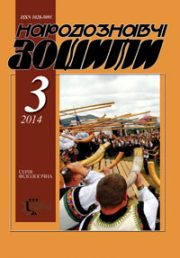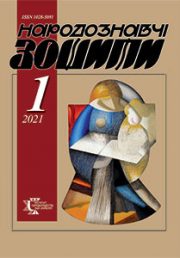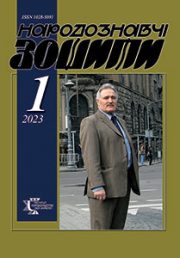The Ethnology Notebooks. 2023. № 2 (170), 353—360
UDK[069.01:[728.6:39]](477.83-25)(091)
DOI https://doi.org/10.15407/nz2023.02.353
HODOVANSKA Oksana
- ORCID ID: https://orcid.org/0000-0002-8297-2414
- Candidate of Historical Sciences (= Ph.D. in History),
- Senior research fellow, Ethnology Institute of the National Academy of Sciences of Ukraine,
- Department of Social Anthropology,
- 15, Svobody Avenue, 79000, Lviv, Ukraine;
- Department of History, Museum Studies and Cultural Heritage,
- Lviv Polytechnic National University,
- 12, Bandera street, 79013, Lviv, Ukraine,
- Contacts: e-mail: oksana.m.hodovanska@lpnu.ua
Abstract. In Ukraine, museums are an important component of the institutions working with collective memory and national identity. The preparatory analysis of the latest research and publications shows the presence of a significant number of studies considering the place and role of cultural heritage in modern society. These studies examine a range of issues related to the preservation and protection of the historical and cultural sites of Ukraine as well. The purpose of the proposed survey is to determine the effectiveness of the transformation of cultural heritage objects into museum exhibits. The Law of Ukraine “On Protection of Cultural Heritage” offers definitions of cultural heritage objects and a system of means for preserving, restoring or using heritage objects. Conservation, restoration, renovation, rehabilitation, adaptation and museification of cultural heritage objects are important among the means.
A distinctive feature of the exposition of the Museum of Folk Architecture and Life named after Klymentii Sheptytskyi was the predominance of wooden buildings. Among them, there were significantly fewer copies than in the museums of Kyiv or Pereyaslav-Khmelnytskyi, where the need to display a large number of non-disassembled exhibits was outweighed by the principle of their originality. In the process of museification, museum scientists encountered many difficulties in choosing and reproducing future exhibits. During museification, not only the museum-expositional usage of cultural heritage objects takes place, also the preservation of their historical, aesthetic, artistic value, their evidence of events, facts, life and activities of people or communities. This is one of the ways to transform cultural heritage objects into a real, integral part of national culture. Therefore, during the museification process, it is important to preserve both the material structure and location of heritage objects, as well as intangible evidence of cultural heritage.
The research methodology is based on theoretical analysis, systematization and generalization, historical review and observations of the author.
Keywords: museification, museum, cultural heritage, scan sen, Lviv.
Received 28.02.2023
REFERENCES
- Zdioruk, S., Lytvynenko, O. & Rozumna, O. (2012). Cultural policy of Ukraine: national model in the European context: analytical report. Kyiv: NISD. Retrieved from: https://niss.gov.ua/sites/default/files/2013-02/Kultura_Zdioruk-beb1d.pdf (Last accessed: 25.1.2023) [in Ukrainian].
- Horbyk, V., Doroshko, O. Kot, C., Lugova, O., & etc. (1998). Historical and cultural heritage: problems of research and preservation. Kyiv. Retrieved from: http://resource.history.org.ua/item/0014571 (Last accessed: 25.1.2023) [in Ukrainian].
- Danylyuk, A., Krasovskyi, I. & Yanov, V.(1980). Museum of Folk Architecture and Life in Lviv: guidebook. Lviv: Kamenyar. Retrieved from: https://chtyvo.org.ua/authors/Danyliuk_Arkhyp/Muzei_narodnoi_arkhitektury_ta_pobutu_u_Lvovi_putivnyk/ (Last accessed: 27.02.2023) [in Ukrainian].
- Law of Ukraine «On Protection of Cultural Heritage». Retrieved from: https://zakon.rada.gov.ua/laws/show/1805-14#Text (Last accessed: 25.01.2023) [in Ukrainian].
- Griffen, L., & Tytova, O. (2015). Use of objects of cultural heritage. Severshchyna in the history of Ukraine, 8, 6—9. Retrieved from: http://dspace.nbuv.gov.ua/bitstream/handle/123456789/127538/03-Hriffen.pdf?sequence=1 (Last accessed: 27.02.2023) [in Ukrainian].
- Danyliuk, A. (1997). Through the prism of time. The Ethnology notebooks, 2. Retrieved from: https://shron1.chtyvo.org.ua/Danyliuk_Arkhyp/Kriz_pryzmu_chasu.pdf? (Last accessed: 27.02.2023) [in Ukrainian].
- Krasovsky, I. (1975). Museum of folk architecture and life in Lviv: guidebook. Lviv: Kamenyar. Retrieved from: https://etnoua.info/wp-content/gallery/mnap_lviv_putivnyk_1975/MNAP_Lviv_1975_06_web.jpg (Last accessed: 27.02.2023) [in Ukrainian].
- Hudchenko, Z. (1981). Museum of folk architecture. Kyiv: Budivelnyk [in Ukrainian]. Retrieved from: https://shron1.chtyvo.org.ua/Hudchenko_Zoia/Muzei_narodnoi_arkhitektury_Ukrainy.pdf? (Last accessed: 27.02.2023).
- Tytova, O. (2009.) Preservation of immovable monuments of archeology in reserves and museums. Proceedings of the Center for Monument Studies, 15, 83—86. Retrieved from: http://dspace.nbuv.gov.ua/bitstream/handle/123456789/14242/07-Titova.pdf?sequence=1 (Last accessed: 27.02.2023) [in Ukrainian].
- Sklokina, I. (2015). Local museums in a dynamic world: (post)soviet heritage and future. Lviv. Retrieved from: https://openplace.com.ua/lokalni-muzeyi-u-dynamichnomu-sviti-post-radyanska-spadshhyna-ta-majbutnye/ (Last accessed: 27.02.2023) [in Ukrainian].
- Brych, M. (2020). Architectural and spatial organization of open-air museums in Ukraine. (PhD dissertation). Lviv Polytechnic National University. Retrieved from: https://lpnu.ua/sites/default/files/2020/dissertation/3802/brychdysertaciya.pdf (Last accessed: 27.02.2023) [in Ukrainian].
- Lysyy, I. (2017). Vectors of museumization of castles of Ivano-Frankivsk region. Military-historical meridian, 16, 75—87. Retrieved from: https://vim.gov.ua/pages/_journal_files/12.07.2017/pdf/VIM_16_2017-75-87.pdf (Last accessed: 27.02.2023) [in Ukrainian].







